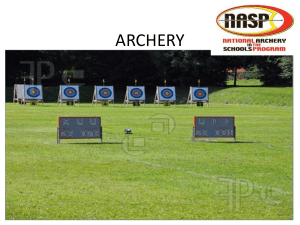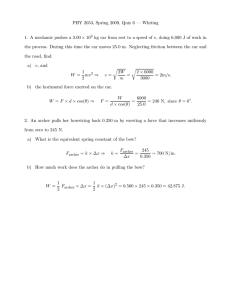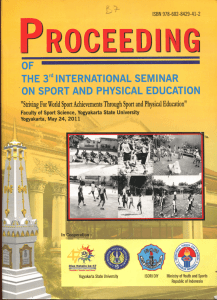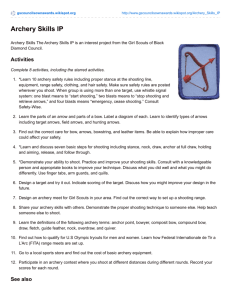TO IMPROVE SKILLS ARCHERY
advertisement
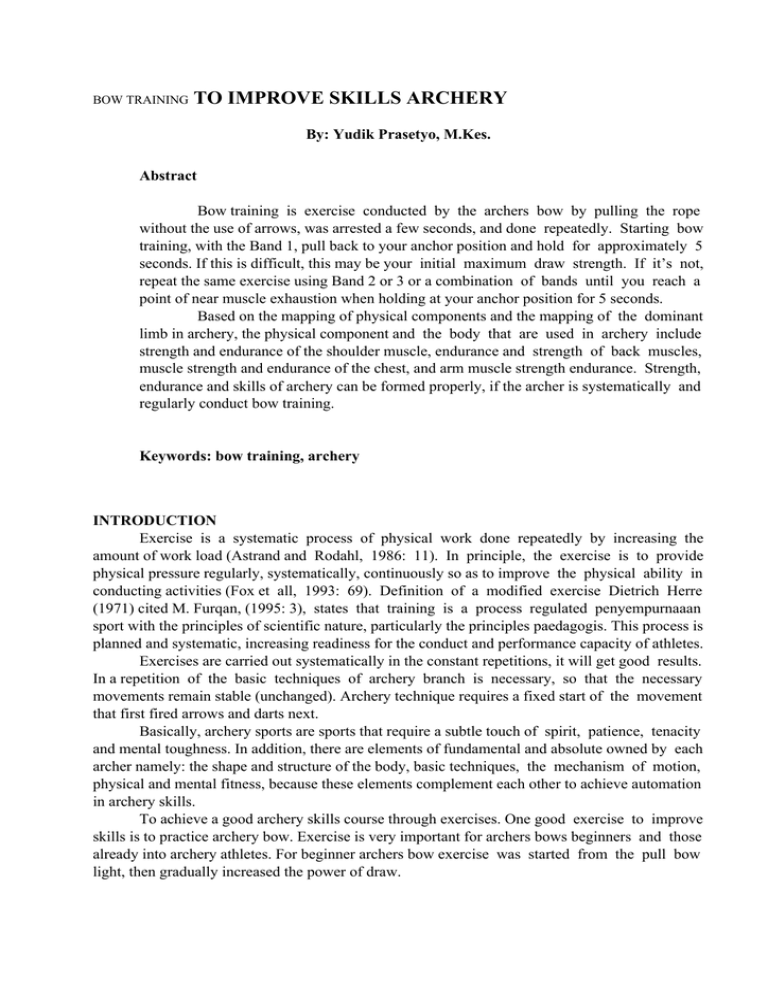
BOW TRAINING TO IMPROVE SKILLS ARCHERY By: Yudik Prasetyo, M.Kes. Abstract Bow training is exercise conducted by the archers bow by pulling the rope without the use of arrows, was arrested a few seconds, and done repeatedly. Starting bow training, with the Band 1, pull back to your anchor position and hold for approximately 5 seconds. If this is difficult, this may be your initial maximum draw strength. If it’s not, repeat the same exercise using Band 2 or 3 or a combination of bands until you reach a point of near muscle exhaustion when holding at your anchor position for 5 seconds. Based on the mapping of physical components and the mapping of the dominant limb in archery, the physical component and the body that are used in archery include strength and endurance of the shoulder muscle, endurance and strength of back muscles, muscle strength and endurance of the chest, and arm muscle strength endurance. Strength, endurance and skills of archery can be formed properly, if the archer is systematically and regularly conduct bow training. Keywords: bow training, archery INTRODUCTION Exercise is a systematic process of physical work done repeatedly by increasing the amount of work load (Astrand and Rodahl, 1986: 11). In principle, the exercise is to provide physical pressure regularly, systematically, continuously so as to improve the physical ability in conducting activities (Fox et all, 1993: 69). Definition of a modified exercise Dietrich Herre (1971) cited M. Furqan, (1995: 3), states that training is a process regulated penyempurnaaan sport with the principles of scientific nature, particularly the principles paedagogis. This process is planned and systematic, increasing readiness for the conduct and performance capacity of athletes. Exercises are carried out systematically in the constant repetitions, it will get good results. In a repetition of the basic techniques of archery branch is necessary, so that the necessary movements remain stable (unchanged). Archery technique requires a fixed start of the movement that first fired arrows and darts next. Basically, archery sports are sports that require a subtle touch of spirit, patience, tenacity and mental toughness. In addition, there are elements of fundamental and absolute owned by each archer namely: the shape and structure of the body, basic techniques, the mechanism of motion, physical and mental fitness, because these elements complement each other to achieve automation in archery skills. To achieve a good archery skills course through exercises. One good exercise to improve skills is to practice archery bow. Exercise is very important for archers bows beginners and those already into archery athletes. For beginner archers bow exercise was started from the pull bow light, then gradually increased the power of draw. BOW TRAINING Bow training is exercise conducted by the archers bow by pulling the rope without the use of arrows, was arrested a few seconds, and done repeatedly. Bow training is a unique training tool that can help archers obtain greater accuracy by improving their form and increasing their strength and stamina. Bow training is the perfect training tool for archers of any age and level of experience–from novice to seasoned professional. Many factors can disrupt an archer’s ability to train consistently during their off-season. When their competitive or hunting season arrives, they pick up their bow and find they’ve lost some strength. With less strength and less stamina their accuracy suffers. It’s human nature. With the bow training program archers can train almost anywhere for optimum strength and accuracy (Kevin C Paulson, 2010: http://www.bow-trainer.com/about/, accessed on May 6, 2011). METHOD OF BOW TRAINING To measure your draw length, you must determine the length of your arm span in inches. Stand with your arms out and palms facing forward. Measure from the tip of one middle finger to the tip of the other. Then, simply divide your measurement by 2.5. If you are of average proportions, your arm span will roughly equal your height. Picture 1. Draw lenght As you begin training with the bow training, make a mental note of your anchor position. Pull the number one band until you reach your draw length, identifying a reference point such as your jaw, the tip of your nose, etc. Review the proper mechanics for drawing the bow training: 1. Place feet shoulder width apart with an open stance. 2. Hold your bow hand at shoulder height. 3. Grasp exercise bands with three fingers of the draw hand (index, middle, and ring fingers). 4. Pull bands with draw arm in upper position, also "in-line" with shoulders, to your anchor position. Picture 2. Anchor position It’s important to understand that the recommended process for successful training program is to build strength over time. Don’t try to pull too much too soon as you could experience muscle strain and damage. Starting with the Band 1, pull back to your anchor position and hold for approximately 5 seconds. If this is difficult, this may be your initial maximum draw strength. If it’s not, repeat the same exercise using Band 2 or 3 or a combination of bands until you reach a point of near muscle exhaustion when holding at your anchor position for 5 seconds. Picture 3. Band position (Kevin C Paulson, 2010: http://www.bow-trainer.com/instructions/, accessed on May 3, 2011). SKILL ARCHERY Sport archery actually a combination of sport and art. Called the sport because of its activity using the muscles, both local muscle or muscles are trained to form the functional components of biomotor abilities. Called art because it requires a touch of soul in subtle feelings, and mental endurance. Webster (1972:8) says "Archery is an artistic skill or sport shooting arrows with a bow. " "Archery is a sport for all ages and all kinds as well as very attractive, can be done alone or together. Archery sports can be done by men and women, children and people with disabilities, people skilled and trained or not trained because everyone will get a satisfaction with archery. Archery has long been recognized as a sport of individuals and families”. Seven action steps are the basic techniques of archery skills are based on the conceptions of space (space), power / energy (force) and accuracy (precision). The mechanism of regular motion, directed, planned and has a permanent stage in the formation of good body posture as a constructive building which will provide strength and physical comfort, either at the time of draw weights, lifting weights and weight-bearing. The occurrence of a regular step will reduce the smallest possible deviation path arrows. The physical condition is the most important thing for an athlete. In sports archery, an archer physical condition very supportive to be able to implement good engineering practice. Seeing the nature of sport archery, the strength factor plays a more important than other factors. Saidel (1975: 89-90) says that archery is an activity that requires strength and can do all the people. Based on the mapping of physical components and the mapping of the dominant limb in archery, the physical component and the body that are used in archery include strength and endurance of the shoulder muscle, endurance and strength of back muscles, muscle strength and endurance of the chest, and arm muscle endurance strength. Strength and endurance can be formed properly, if the archer is systematically and regularly conduct bow training. CONCLUSION To achieve a good archery skills course through exercises. One good exercise to improve skills is to practice bow training. Bow training is a unique training tool that can help archers obtain greater accuracy by improving their form and increasing their strength and stamina. Bow training is the perfect training tool for archers of any age and level of experience–from novice to seasoned professional. REFERENCES Astrand P.O. & Rodahl. K. (1986). Text Book of Work Physiology, second edition. Mc. Graw Hill Company. Fox E.L., Bowers R.W. and Fross M.L. (1993). The Physiological Basis of Exercise and Sport. USA: Wim. Brown Publisher. Furqon, M. (1995). Teori Umum Latihan. Surakarta: Universitas Sebelas Maret Press. Kevin C Paulson. (2010) http://www.bow-trainer.com/instructions/, accessed on May 3, 2011. Kevin C Paulson. (2010). http://www.bow-trainer.com/about/, accessed on May 6, 2011. Saidel. Beverly. L. (1975). Sport Skill: A Conceptual Approach to Meaningful Movement, WM.C. Brown Company Publishers, Duduque. Webster.M. (1972). Webster’s Sport Dictionary, C and C Merian C.P, Springfield. Massachusetts.
